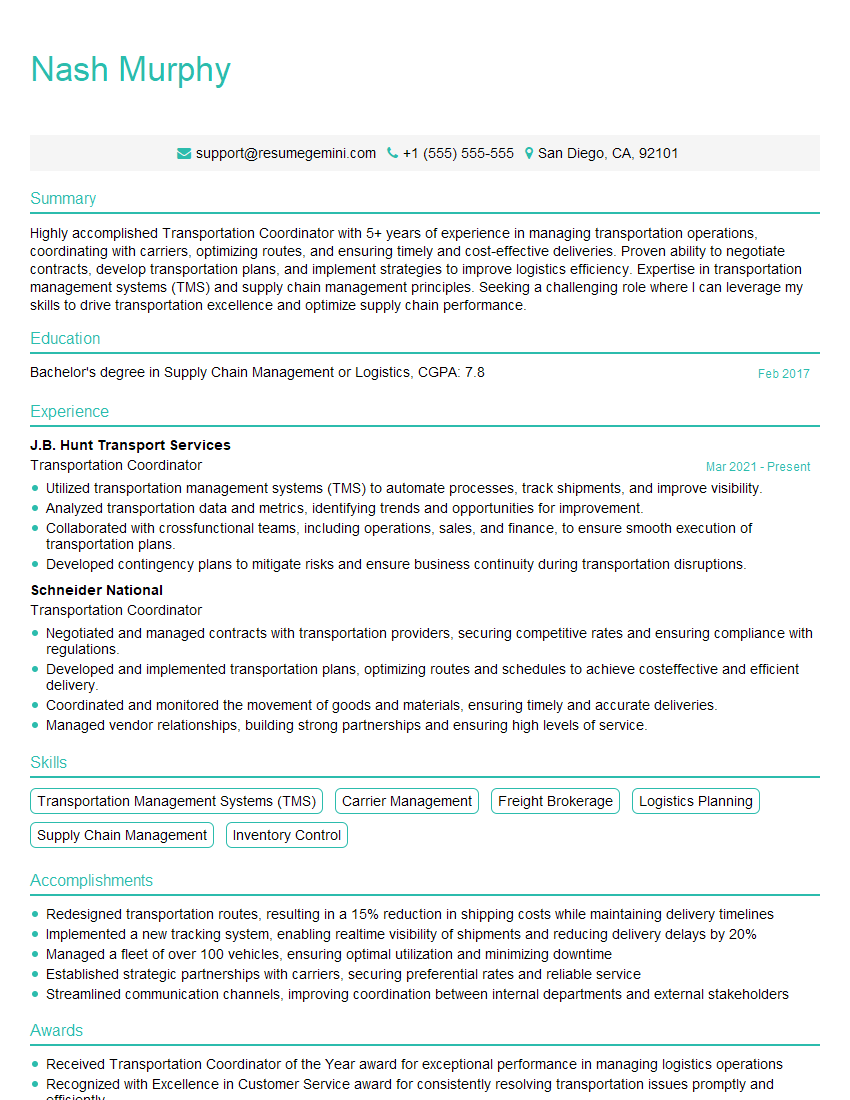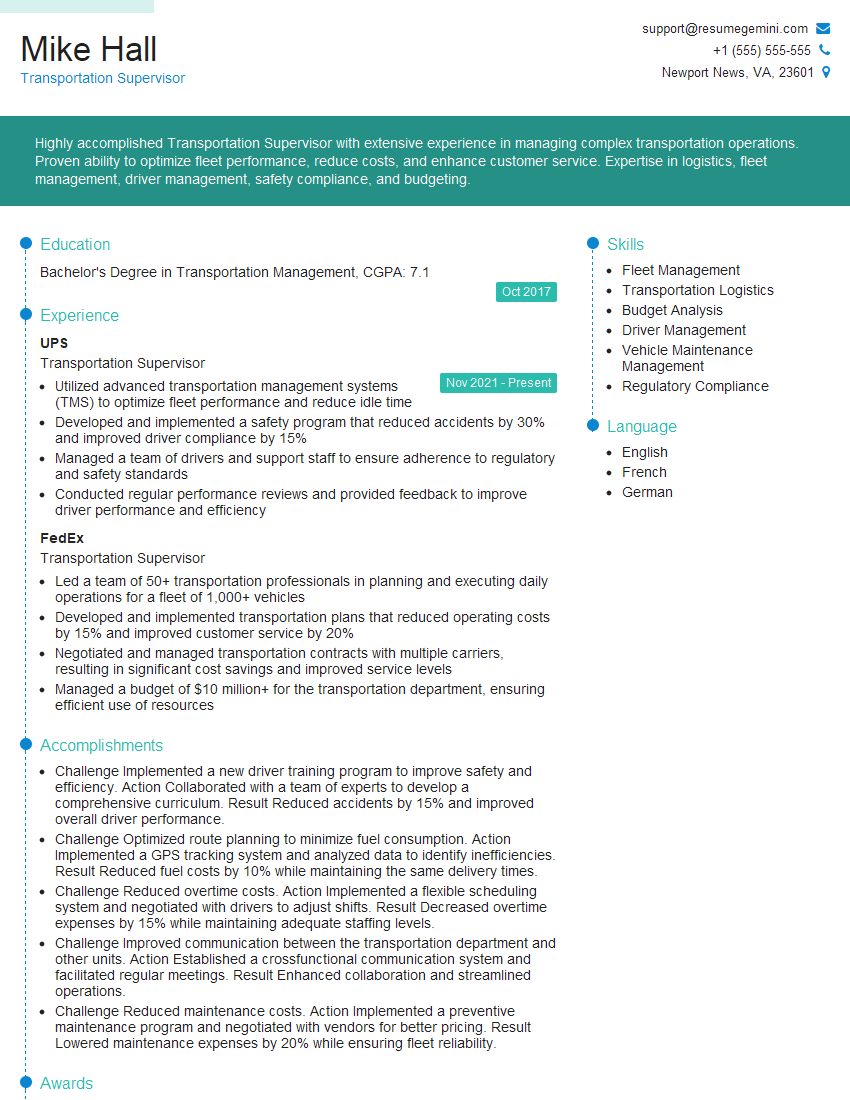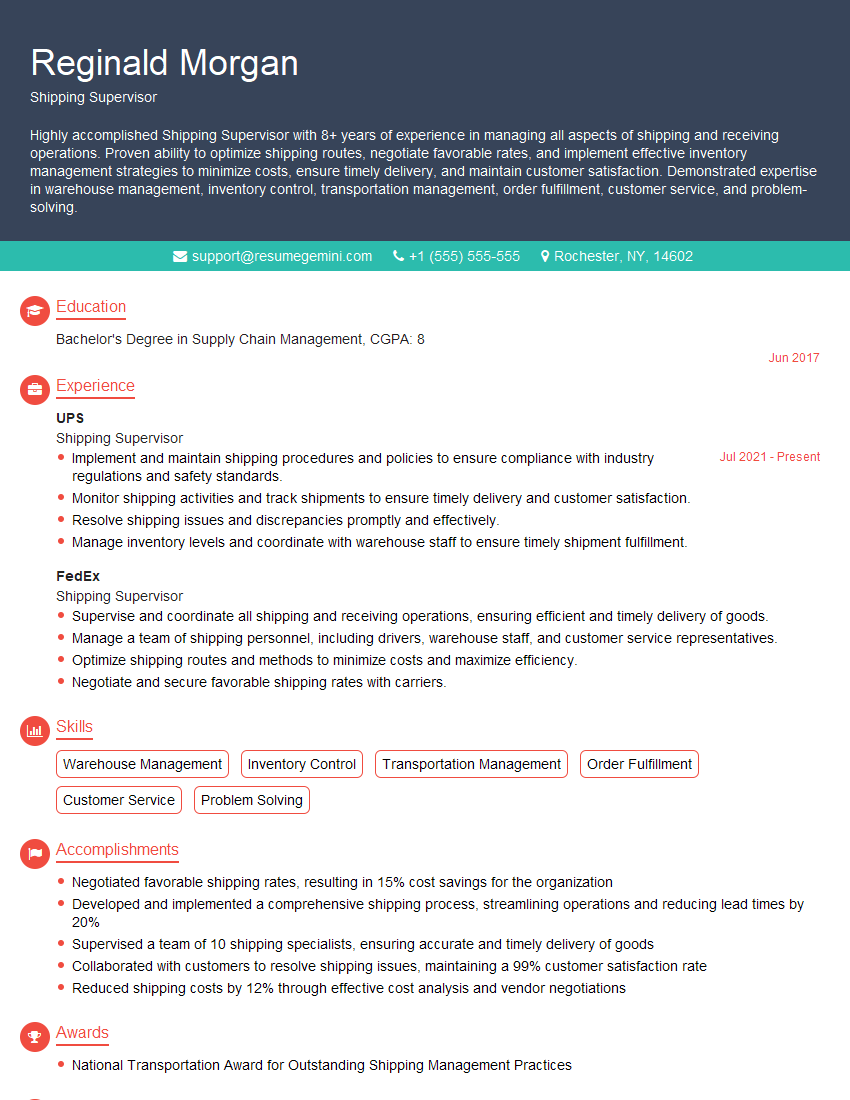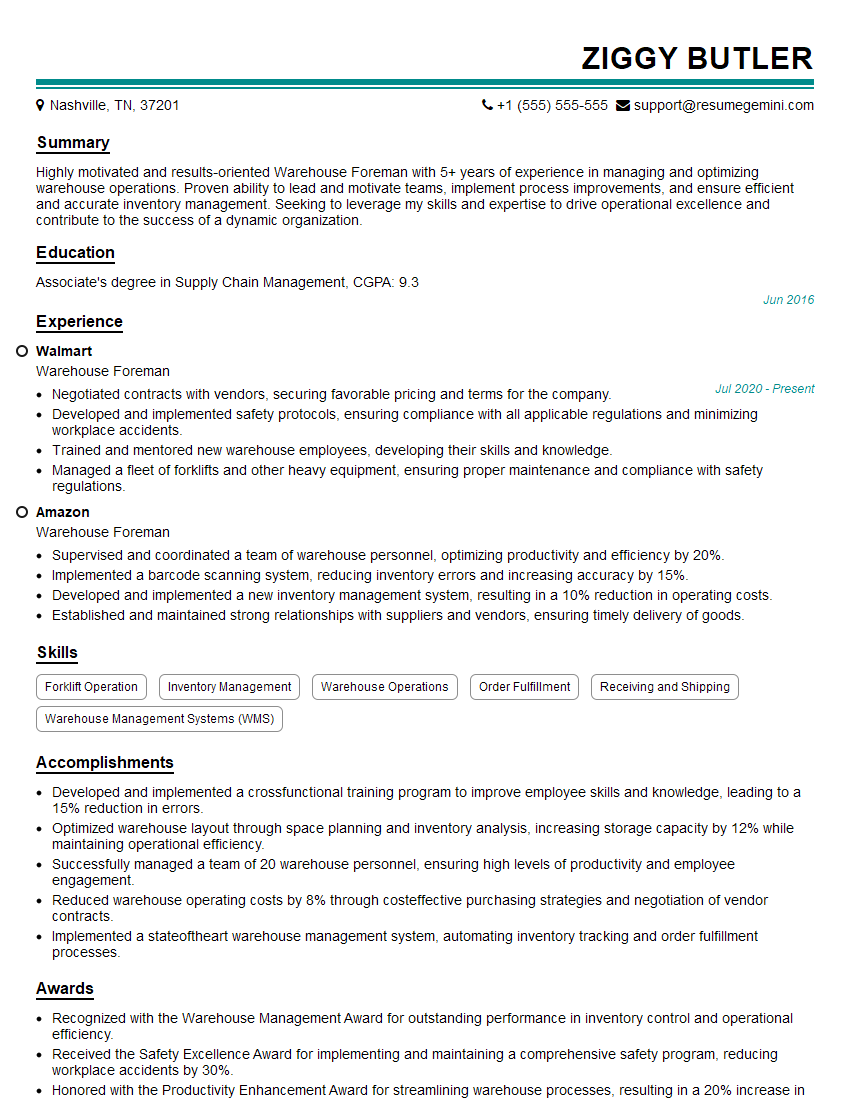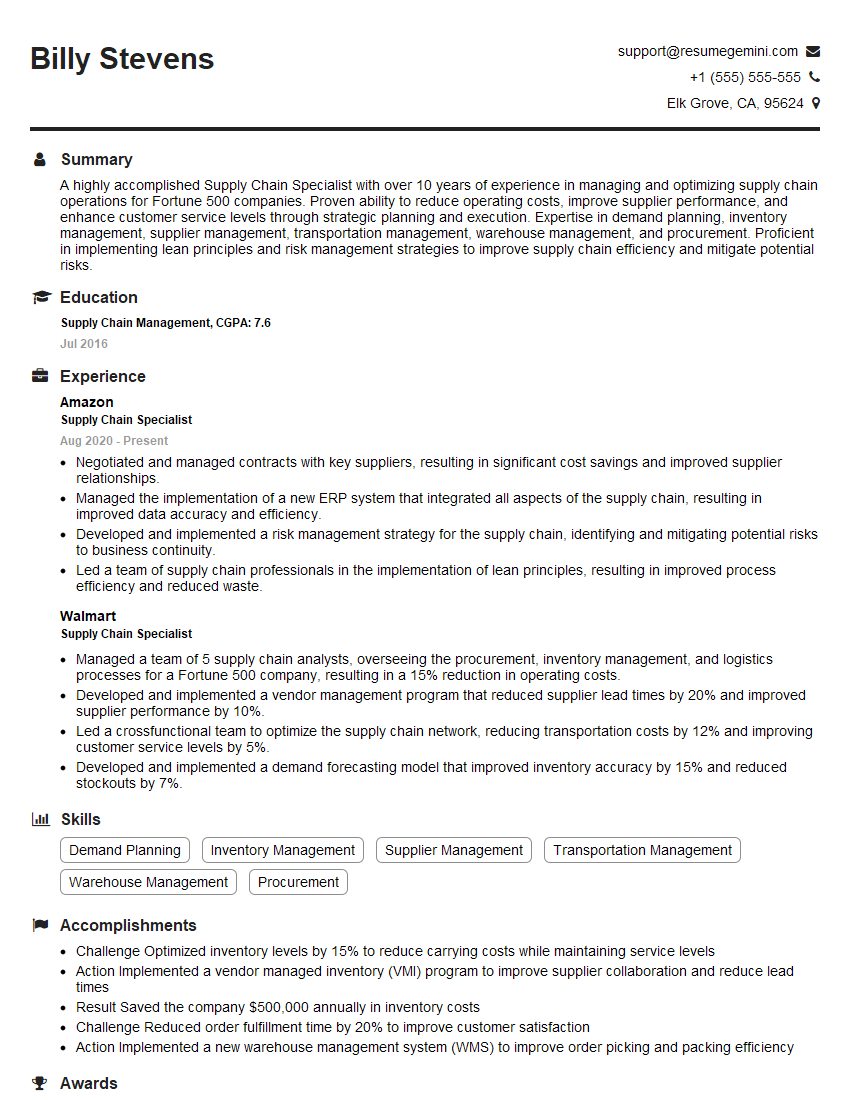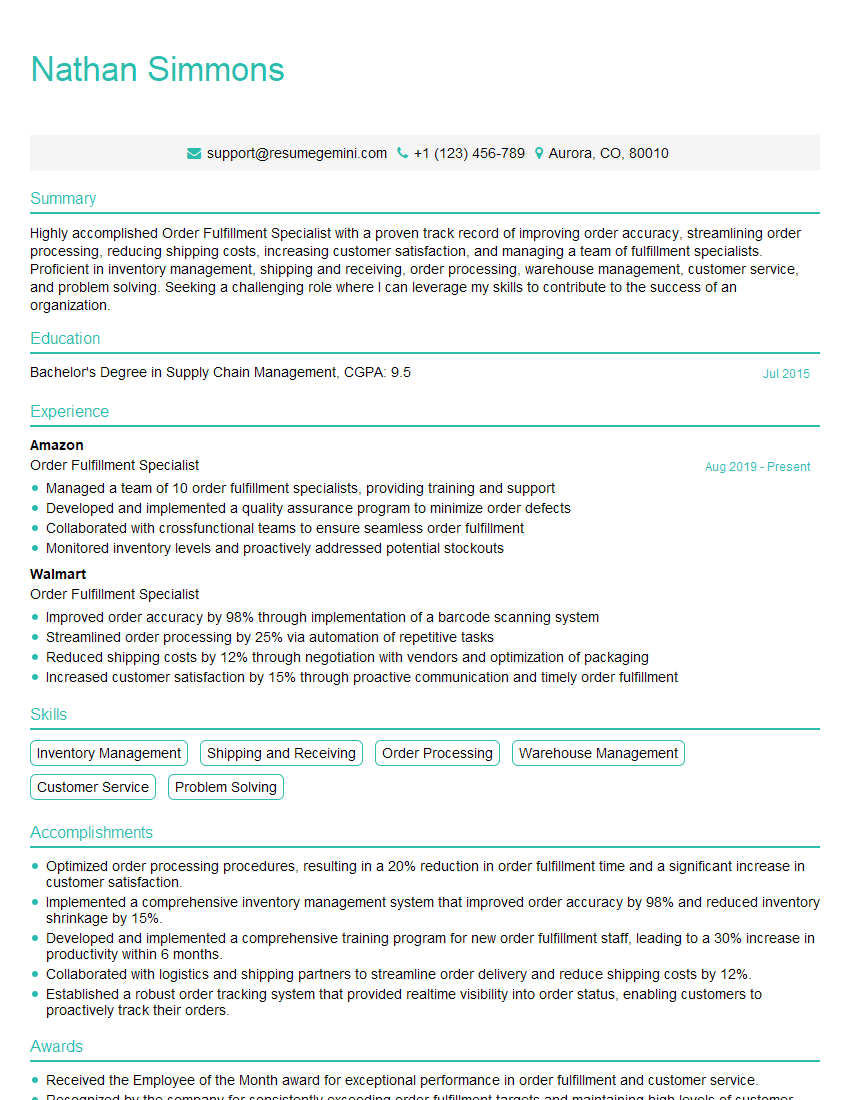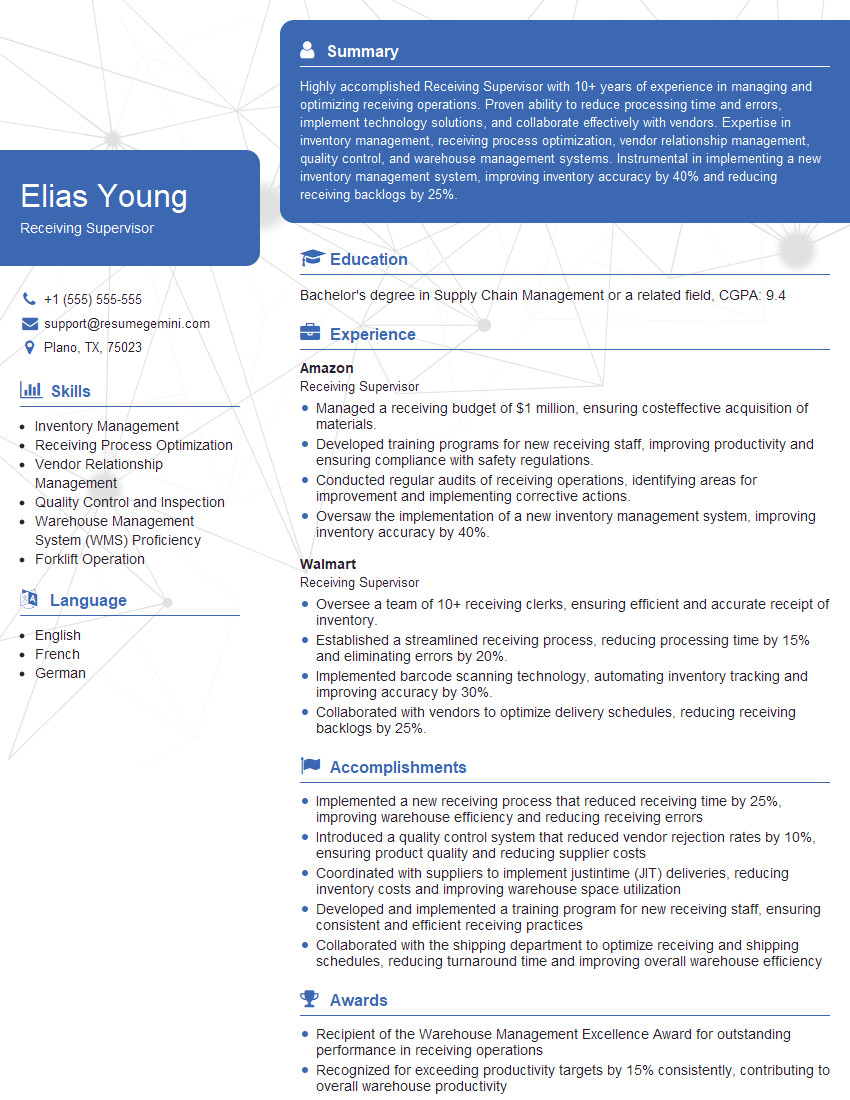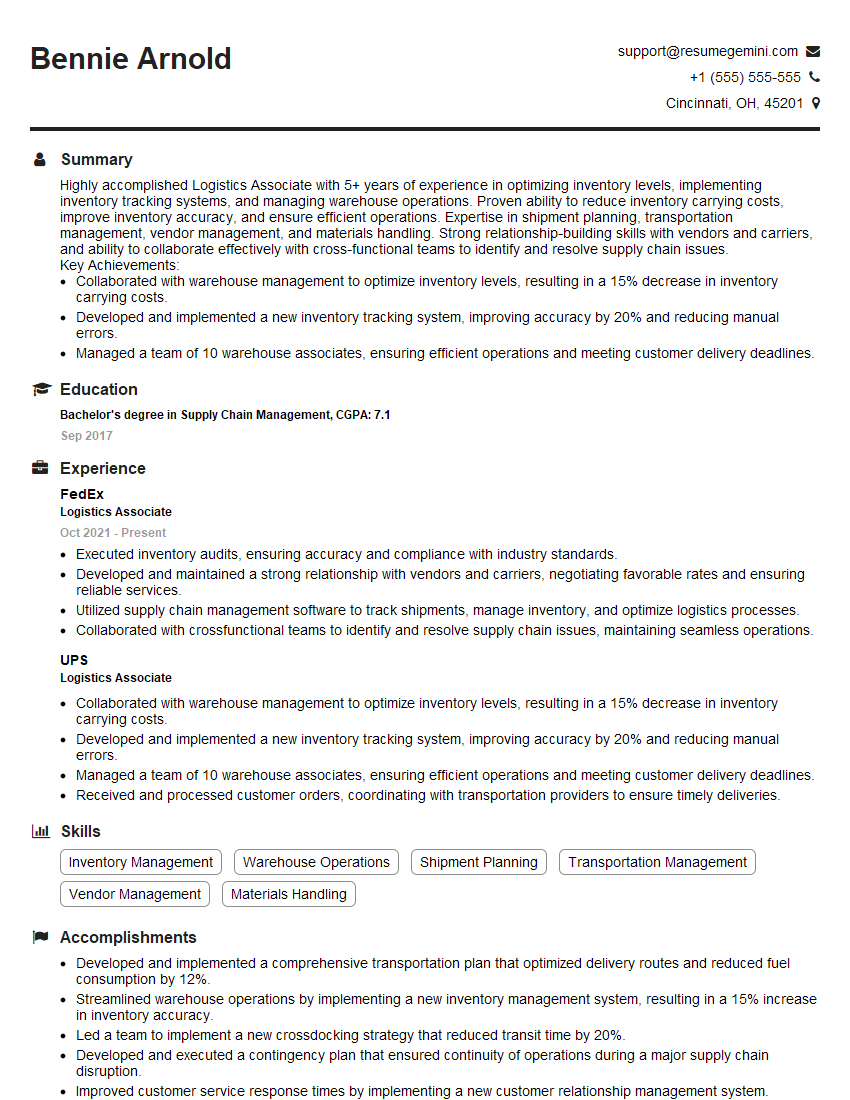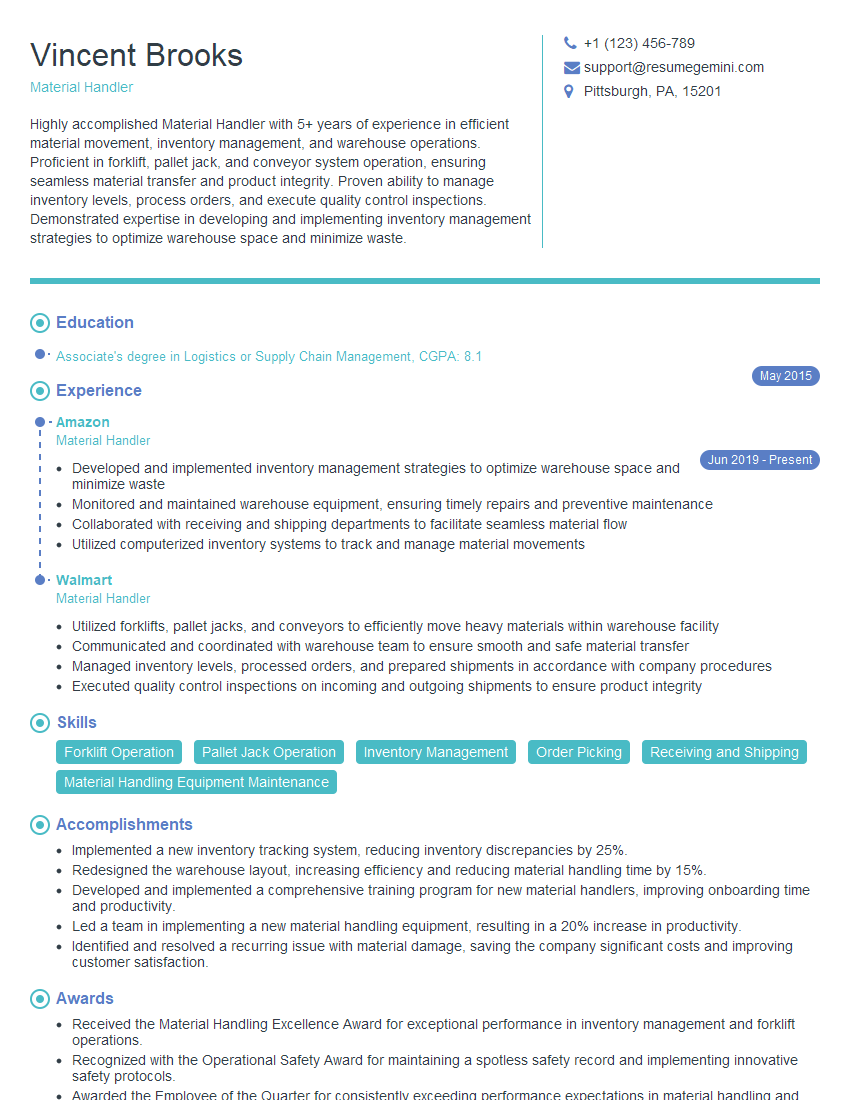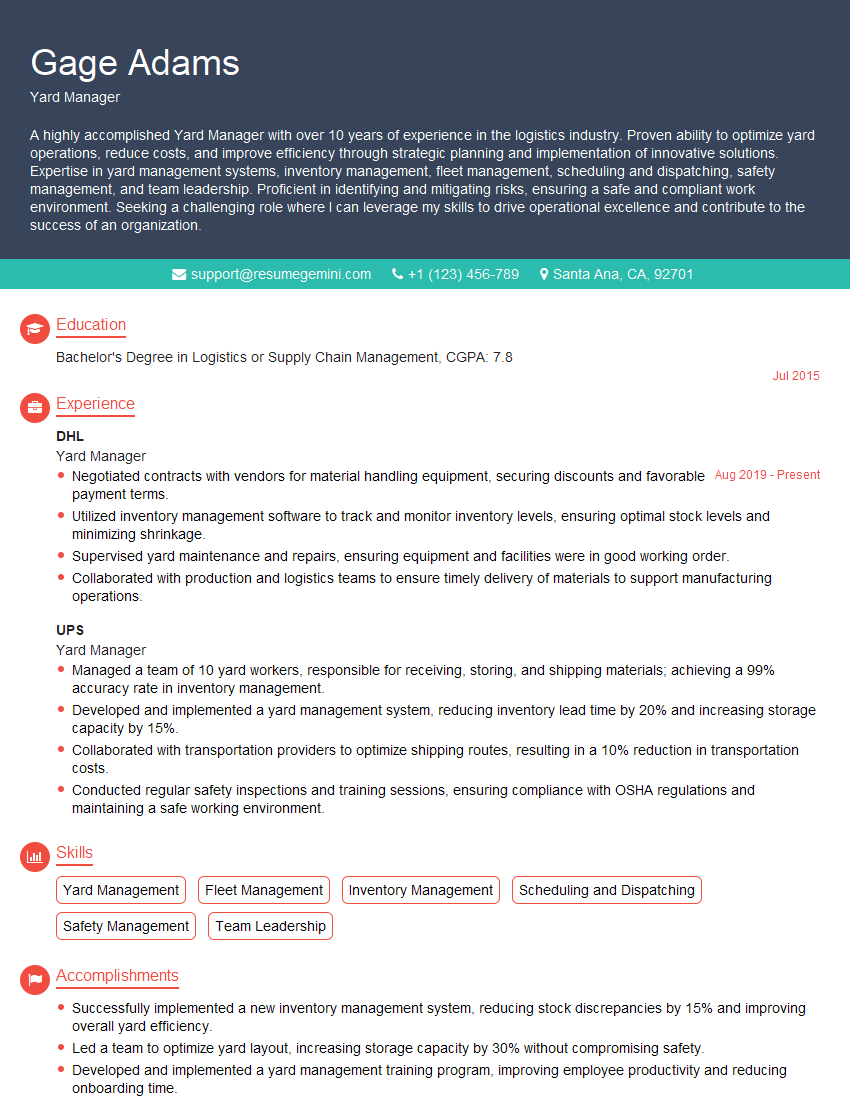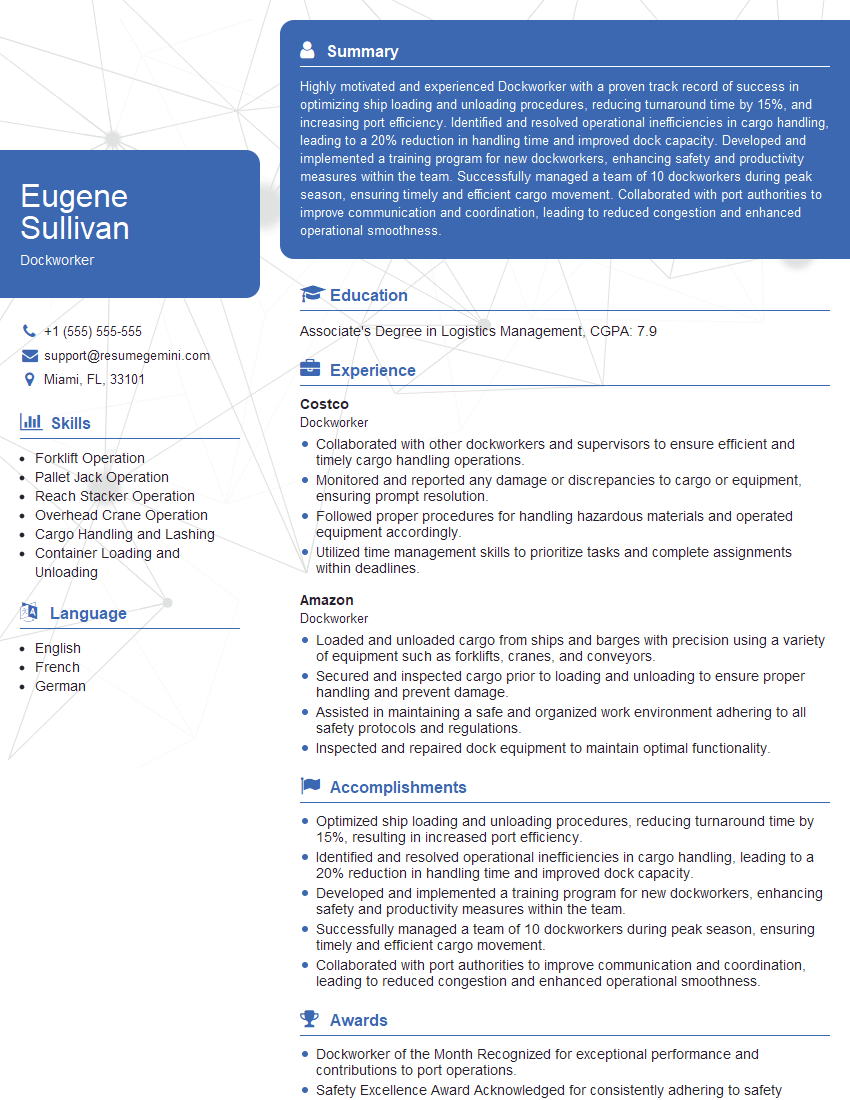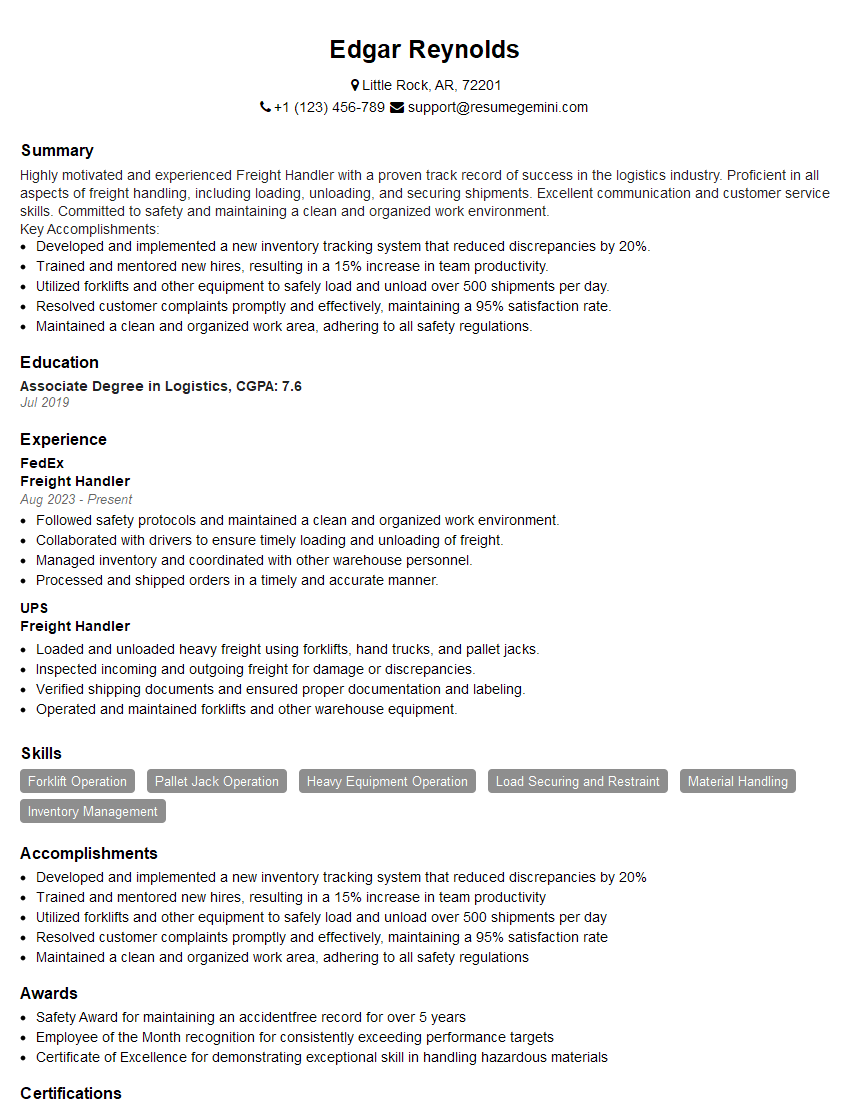Cracking a skill-specific interview, like one for Dock Plate Operation, requires understanding the nuances of the role. In this blog, we present the questions you’re most likely to encounter, along with insights into how to answer them effectively. Let’s ensure you’re ready to make a strong impression.
Questions Asked in Dock Plate Operation Interview
Q 1. What are the different types of dock plates?
Dock plates come in various types, each designed for specific needs and weight capacities. The most common types include:
- Steel Dock Plates: These are the most durable and widely used, offering high weight capacity and resistance to damage. They are available in various sizes and thicknesses.
- Aluminum Dock Plates: Lighter than steel, these are ideal for situations where weight is a major concern, such as applications involving forklifts. However, they have a lower weight capacity compared to steel.
- Plastic Dock Plates: While less durable than steel or aluminum, they are corrosion-resistant and suitable for lighter loads and specific environments. Often used in food processing or chemical facilities.
- Extendable Dock Plates: These adjustable plates bridge gaps of varying widths, offering flexibility in different loading scenarios. They usually have a locking mechanism to ensure secure placement.
- Specialty Dock Plates: There are also plates designed for specific purposes like those with beveled edges for easier wheel transitions or those with extra-wide platforms for heavy machinery.
Choosing the right dock plate depends entirely on the weight of the load, the type of equipment used, and the environment.
Q 2. Describe the procedure for safely installing a dock plate.
Safe dock plate installation is crucial for preventing accidents. Here’s a step-by-step procedure:
- Assessment: Ensure the dock leveler is properly positioned and stable. Check the gap between the truck and the dock to determine the appropriate dock plate length.
- Selection: Choose a dock plate with a weight capacity exceeding the combined weight of the forklift and its load.
- Placement: Carefully position the dock plate, ensuring it’s securely resting on both the dock and the truck bed. Align it properly to avoid creating uneven surfaces or dangerous angles.
- Securing: Use appropriate securing mechanisms, such as built-in locking pins or chains, to prevent the dock plate from shifting or moving during loading or unloading. Ensure these mechanisms are properly engaged.
- Testing: Before operating any equipment, gently test the dock plate’s stability by applying a small amount of weight to ensure it’s firmly in place. Listen and look for any unusual sounds or movement.
Remember that proper training is essential before attempting to install and use a dock plate. Improper installation can lead to serious accidents.
Q 3. How do you ensure a dock plate is properly secured?
Securely fastening a dock plate is paramount for safety. Methods include:
- Lip-style Plates: These plates often have built-in lips or extensions that rest securely on the dock and the vehicle, preventing slippage.
- Securing Pins or Bolts: Many dock plates come with locking pins or bolts that engage with the dock or vehicle, further improving stability. Ensure these are firmly in place.
- Wheel Chocks: In addition to the dock plate’s securing mechanisms, wheel chocks can provide an added level of security, preventing the vehicle from rolling.
- Chain Restraints: Using chains attached to the dock plate and secured to the dock or vehicle adds further protection against movement.
- Regular Inspections: Before each use, check all securing mechanisms to make sure they’re intact and functional. Replace or repair any damaged components immediately.
The key is redundancy. Employing multiple securing methods greatly minimizes the risk of accidents.
Q 4. What are the weight limits for various dock plate types?
Weight limits vary greatly depending on the dock plate’s material, size, and construction. For example:
- Steel Dock Plates: Can range from a few thousand pounds for smaller plates to tens of thousands of pounds for heavier-duty plates.
- Aluminum Dock Plates: Generally have lower weight limits than steel plates of the same size due to the material’s lower strength.
- Plastic Dock Plates: Typically have the lowest weight capacities, suitable only for lightweight loads.
Always check the manufacturer’s specifications for the exact weight limit of the dock plate being used. Exceeding this limit can cause serious structural failure and lead to injury or property damage. Never rely on estimates.
Q 5. How do you inspect a dock plate for damage before use?
A thorough pre-use inspection is vital for safety. Check for:
- Cracks and Breaks: Inspect the entire surface for any cracks, fractures, or breaks, paying close attention to the edges and high-stress areas.
- Bending or Warping: Check for any signs of bending or warping that may indicate the plate has been overloaded or damaged.
- Missing or Damaged Components: Examine the securing mechanisms (pins, bolts, etc.) to ensure they are in good condition and properly functional. Replace any damaged or missing parts immediately.
- Corrosion: Look for signs of corrosion, especially in steel plates. Extensive corrosion can weaken the plate and reduce its weight capacity.
- Loose Rivets or Welds: Check for any loose rivets or welds that could compromise the plate’s structural integrity.
If any damage is found, the dock plate should be removed from service and replaced with a suitable undamaged alternative.
Q 6. What safety precautions should be taken when operating a dock plate?
Safety precautions are critical when operating a dock plate. These include:
- Proper Training: All personnel using dock plates must receive adequate training on safe installation, use, and maintenance procedures.
- Weight Limits: Never exceed the plate’s weight capacity as indicated on the plate itself.
- Clear Communication: Maintain clear communication between personnel operating the forklift, the dock plate, and the receiving/shipping crew.
- Stable Surface: Ensure the dock leveler is properly positioned and stable before using the dock plate.
- Personal Protective Equipment (PPE): Wear appropriate PPE, such as steel-toed boots and gloves, when working with dock plates.
- Proper Lifting Techniques: If manually handling the plate (which is discouraged for heavier plates), use proper lifting techniques to avoid injuries.
- Barrier Control: Consider using traffic control devices to delineate the work area, especially during busy periods.
Adhering to these safety precautions minimizes the risks of accidents and injuries.
Q 7. What are the potential hazards associated with improper dock plate use?
Improper dock plate use poses several serious hazards:
- Falls: An unsecured or damaged plate can cause workers or equipment to fall, leading to severe injury.
- Equipment Damage: Overloading or improper use can damage the dock plate, the forklift, or the goods being transported.
- Injuries: Crushing injuries are a common risk associated with falling equipment or collapsing dock plates.
- Property Damage: The failure of a dock plate can result in damage to the dock, building, and the transported goods.
- Legal Issues: Workplace accidents related to improper dock plate use can lead to significant legal repercussions and financial penalties.
Regular inspection, maintenance, and proper training are crucial for preventing these hazards and ensuring a safe working environment.
Q 8. How do you handle a situation where a dock plate becomes damaged during operation?
Discovering a damaged dock plate during operation requires immediate action to prevent accidents and further damage. First, I would immediately halt all loading and unloading activities. Safety is paramount. Then, I’d assess the extent of the damage. Minor dents or scratches might be acceptable depending on the dock plate’s overall condition and the manufacturer’s guidelines. However, any significant damage, such as cracks, bends, or significant wear on the lip, necessitates immediate removal from service. I would then clearly mark the dock plate as ‘out of service’ and report the damage to my supervisor immediately. A detailed report including photos and a description of the damage would be essential for determining the cause and planning repairs or replacement. For instance, if a forklift hit the edge, that information is crucial for future safety training and adjustments to loading procedures. Finally, a replacement dock plate would be sourced and installed, ensuring all safety protocols are followed during the replacement process.
Q 9. What is the correct procedure for removing a dock plate?
Removing a dock plate safely requires a systematic approach. First, ensure the dock plate is free from any weight or load. This is critical. Next, I’d engage the dock leveler’s safety mechanisms (typically a locking pin or lever) to prevent accidental movement. If using a manually operated dock leveler, then the leveler needs to be fully retracted before attempting to remove the plate. Once the dock leveler is fully retracted and secured, I carefully disengage the dock plate from the dock leveler and the truck bed. This process often involves using the appropriate levers or pins on the dock plate itself. Once disengaged, the plate can then be carefully lifted and moved aside to a designated storage area, preferably one which is clean and dry. Using a proper lifting technique—avoiding back strain and potentially damaging the plate further—is essential. This is where teamwork can be very useful. A second person assisting with lifting and moving is ideal for larger and heavier dock plates.
Q 10. What type of training have you received in dock plate operation?
My training in dock plate operation is comprehensive and includes both theoretical and practical components. I’ve undergone formal training that covers OSHA regulations pertaining to safe loading dock practices, proper operation of different types of dock plates (including bridge plates, hinged plates and others), identification of potential hazards, and emergency procedures. Beyond initial training, I’ve participated in regular safety refreshers and attended workshops focusing on equipment maintenance and best practices. I’ve also received hands-on training under the supervision of experienced professionals, allowing me to gain practical experience in various real-world scenarios. These scenarios included everything from handling minor adjustments to dealing with emergency situations, such as unexpected equipment malfunctions. My continuous learning approach allows me to stay updated on industry standards and best practices.
Q 11. How do you address uneven loading dock surfaces?
Uneven loading dock surfaces pose significant safety risks. To address this, I would first visually inspect the dock surface and the truck bed to assess the degree of unevenness. Slight variations can often be compensated for by carefully positioning the dock plate; however, more significant discrepancies require additional measures. For example, using shims or adjustable ramps under the dock plate to bridge the gap and create a stable and level surface is common practice. The type and number of shims needed depend on the particular situation, always ensuring proper support and stability of the dock plate. Crucially, before using any such methods, I would first make sure the chosen solutions are structurally sound and won’t compromise the stability of the dock plate or create a more hazardous condition. In cases of severe unevenness, I may recommend not proceeding with the loading or unloading until the dock surface itself has been repaired or corrected. Safety is always the priority.
Q 12. Explain the importance of regular dock plate maintenance.
Regular dock plate maintenance is critical for safety and longevity. Neglecting maintenance can lead to equipment failure, creating significant safety hazards and costly repairs or replacements. Regular inspections allow early detection of wear, tear, and potential structural issues. Preventive maintenance, such as lubrication of moving parts, reduces friction and extends the lifespan of the equipment. Promptly addressing minor issues prevents them from escalating into major problems. Maintaining a clean dock plate helps to prevent corrosion and ensures the smooth and safe operation of the equipment. For example, cleaning off any spilled material will prevent corrosion and potential damage to the plates. Regular maintenance not only protects workers but also ensures the efficient and cost-effective operation of the loading dock, minimizing downtime and disruptions.
Q 13. How often should dock plates be inspected?
The frequency of dock plate inspections should be determined by several factors, including the frequency of use, the type of materials being handled, and the overall condition of the plate. However, a minimum of a weekly visual inspection is recommended. This would include checking for any obvious signs of damage, such as bends, cracks, or excessive wear. More frequent inspections (daily or even more frequently) might be necessary for heavily used or high-risk situations. For instance, if the dock plates are used to handle heavier or sharper objects that increase the risk of damage, more frequent inspections may be necessary. In addition to regular visual inspections, more thorough inspections—potentially involving a more detailed examination, perhaps by a qualified professional—should be performed at least annually or more often as needed.
Q 14. What are the signs of a damaged or worn-out dock plate?
Recognizing the signs of a damaged or worn-out dock plate is vital for preventing accidents. Obvious signs include cracks in the metal, significant bends or warping, excessive wear or deformation of the lip (the edge that contacts the truck and dock), and excessive rust or corrosion. Less obvious signs might include loose or damaged welds, excessive play or looseness in moving parts (if applicable to the dock plate design), and dents that might compromise the structural integrity. Also, keep an eye out for unusual sounds or vibrations during use, which might indicate internal damage or problems with the structure. If any of these signs are detected, the dock plate should be immediately removed from service and assessed for repair or replacement. Remember, a compromised dock plate is a serious safety risk.
Q 15. Describe your experience with different types of loading dock equipment.
My experience encompasses a wide range of loading dock equipment, including various types of dock plates. This includes steel dock plates (both standard and heavy-duty), aluminum dock plates (offering lighter weight and corrosion resistance), and specialized plates like those with retractable lips or those designed for specific applications such as handling uneven surfaces or hazardous materials. I’ve also worked with associated equipment such as dock levelers, edge-of-dock seals, and vehicle restraints, all crucial for safe and efficient dock operations. For example, I’ve utilized heavy-duty steel plates for loading palletized materials exceeding 10,000 pounds, while aluminum plates have been perfect for lighter loads where ease of handling is a priority.
- Steel Dock Plates: Robust and durable, ideal for heavy loads.
- Aluminum Dock Plates: Lightweight yet strong, suitable for various applications.
- Specialized Dock Plates: Offer features like retractable lips for gap bridging and improved safety.
Career Expert Tips:
- Ace those interviews! Prepare effectively by reviewing the Top 50 Most Common Interview Questions on ResumeGemini.
- Navigate your job search with confidence! Explore a wide range of Career Tips on ResumeGemini. Learn about common challenges and recommendations to overcome them.
- Craft the perfect resume! Master the Art of Resume Writing with ResumeGemini’s guide. Showcase your unique qualifications and achievements effectively.
- Don’t miss out on holiday savings! Build your dream resume with ResumeGemini’s ATS optimized templates.
Q 16. How do you ensure the compatibility of a dock plate with the truck and dock?
Ensuring compatibility is paramount for safety and efficiency. I meticulously check three key factors: the truck bed height, the dock height, and the dock plate’s weight capacity. First, I measure the gap between the truck bed and the dock using a measuring tape. This determines the required length of the dock plate. Next, I verify the dock plate’s weight capacity rating is sufficient for the load being handled – always erring on the side of caution. Finally, I visually inspect the dock plate itself for any signs of damage (dents, bends, cracks) that would compromise its structural integrity. For instance, if a truck’s bed height is 48 inches and the dock is 52 inches, I would select a dock plate with a minimum of a 4-inch rise. The plate’s weight capacity needs to meet or exceed the weight of the heaviest load. I also make sure the plate is correctly secured to both the truck and the dock before any loading begins.
Q 17. What are your strategies for preventing accidents related to dock plate use?
My accident prevention strategies are multifaceted and prioritize proactive measures. These include regular inspections of dock plates for damage, ensuring proper placement and securing of the plate, and implementing clear communication protocols with both dock workers and truck drivers. We enforce a strict ‘no load on unsecured dock plate’ policy. We regularly provide training on safe operating procedures, emphasizing the dangers of improper usage and the importance of using appropriate personal protective equipment (PPE). I use checklists to ensure steps are followed and maintain detailed records of inspections and any incidents. Furthermore, maintaining a well-lit and organized dock area significantly reduces the risk of trips and falls. Once, I noticed a small crack on a plate – had I not noticed, it could have caused a serious accident during a heavy load transfer. That’s why regular preventative checks are essential.
Q 18. How do you communicate effectively with truck drivers regarding dock plate usage?
Effective communication is crucial. I always approach truck drivers with a professional and respectful demeanor. Before commencing loading or unloading, I clearly explain the procedure, indicating the correct placement and usage of the dock plate, and highlighting safety measures. I use clear, concise language, avoiding jargon, and visually confirming that they understand the instructions. I’ll often show them exactly where to position their truck to minimize the gap. If language is a barrier, I utilize visual aids or translation assistance. Open communication fosters trust and ensures everyone understands their role in ensuring safety and efficiency. I always emphasize the shared responsibility in preventing accidents.
Q 19. Explain the role of dock plates in maintaining efficient loading and unloading processes.
Dock plates are fundamental to efficient loading and unloading operations. They bridge the gap between the truck and the dock, creating a level, safe surface for material handling equipment like forklifts to operate. Without them, loading and unloading would be extremely difficult, time-consuming, and potentially dangerous. They minimize the risk of damage to goods and equipment, and the resulting delays. Their use streamlines the entire process, significantly increasing throughput and productivity. For example, imagine trying to load a pallet onto a truck with a significant height difference – without a dock plate, you risk damaging the goods, injuring workers, and significantly delaying the process.
Q 20. Describe your experience with troubleshooting problems related to dock plate operation.
Troubleshooting involves systematic investigation. I begin by carefully examining the dock plate for any visible damage, including bends, cracks, or loose components. If the issue is related to the dock itself, I check the dock leveler’s functionality. If the plate isn’t level, I check the underlying surface for unevenness. A common issue is a damaged lip. In those cases, either replacement or repair is necessary, depending on the severity. Once, I found a dock plate wouldn’t properly engage due to debris jamming the locking mechanism – a simple cleaning resolved the problem. A documented troubleshooting process helps identify the root cause and ensures a swift solution with minimal downtime.
Q 21. What are your strategies for ensuring the safety of personnel around dock plates?
Safety around dock plates is paramount. My strategy focuses on preventing accidents before they happen. This includes clearly marking areas around the dock plates with warning signs, installing handrails where necessary, and making sure the area is well-lit. I enforce rules regarding proper footwear – steel-toed boots are mandatory. I also ensure that only authorized personnel operate dock plates and that they’ve undergone proper training. Regular safety meetings reinforce safe practices and address any potential hazards. I always maintain clear communication and make sure everyone is aware of their surroundings. For example, designating a ‘no-entry’ zone while a dock plate is in use prevents unintended accidents.
Q 22. How do you handle situations involving heavy equipment and dock plates?
Handling heavy equipment and dock plates requires a meticulous approach prioritizing safety. Think of it like this: you’re bridging a gap between two heavyweights – the truck and the warehouse floor. Before anything moves, a thorough pre-operation inspection is crucial. This involves checking the dock plate’s condition for any damage, ensuring its proper placement, and verifying the levelness of the truck bed relative to the dock. Next, I always communicate clearly with the equipment operator, establishing hand signals or a verbal communication system to coordinate movements. The operator and I would confirm the weight of the load is within the dock plate’s rated capacity. Slow, controlled movements are key. Sudden jerking or abrupt stops can cause damage to the dock plate, the equipment, or even lead to accidents. Finally, after the operation, I always conduct a post-operation check, ensuring the dock plate is safely retracted and stored, leaving the area clear and hazard-free.
For instance, during one loading operation involving a forklift carrying a heavy pallet of machinery, I noticed a slight bend in the dock plate after several passes. We immediately stopped the operation, replaced the plate with a sturdier model, and resumed only after a thorough safety check, preventing potential accidents.
Q 23. What are your knowledge of different materials used in dock plate construction?
Dock plates are constructed from a variety of materials, each with its own advantages and disadvantages. Steel is the most common material due to its high strength-to-weight ratio and durability. Aluminum dock plates are lighter, making them easier to handle and maneuver, but they are not as strong as steel and may not be suitable for extremely heavy loads. For specialized applications requiring high resistance to corrosion or extreme temperatures, you might encounter stainless steel or even composite materials. The choice of material is highly dependent on the intended application, the weight capacity required, and the environmental conditions.
For example, a food processing plant might choose stainless steel plates to maintain hygiene standards, while a warehouse dealing with heavy machinery might opt for high-strength steel plates. Lightweight aluminum plates could be preferred in environments requiring easy handling or frequent movement.
Q 24. How do you determine the appropriate size of dock plate for a given application?
Determining the appropriate dock plate size involves several factors: The weight of the heaviest load being transported is paramount. The length of the plate must bridge the gap between the truck and the dock effectively. The width should accommodate the vehicle’s wheels and the load’s dimensions to prevent overhang, which is a serious safety hazard. Finally, it’s crucial to verify that the chosen dock plate’s weight capacity exceeds the weight of the heaviest load. It’s always better to overestimate and select a dock plate with a higher capacity to maintain a margin of safety.
Consider this: if a delivery truck is carrying a 10,000-pound load, you need a dock plate with a capacity well above that figure, taking into account potential variations in weight. A capacity rating of 12,000 pounds or more would offer a buffer for safety.
Q 25. Describe your experience with different types of loading dock seals and shelters?
My experience includes working with various loading dock seals and shelters designed to optimize the loading and unloading process and protect goods and workers from the elements. These range from simple, fabric-based seals to more sophisticated, inflatable or cushioned seals which offer different levels of protection. Inflatable seals create an airtight seal around the truck, which is great for climate control and helps to improve energy efficiency. Shelters, usually comprised of metal or fabric structures, further extend protection against weather, acting as a buffer zone between the loading dock and the environment.
For example, I’ve worked with facilities using high-speed fabric seals for quick truck turnover, whereas other facilities favored more robust, weatherproof shelters for products that needed protection from the elements during transit.
Q 26. What are the legal and regulatory requirements concerning dock plate operation?
Legal and regulatory requirements regarding dock plate operation are primarily focused on safety. OSHA (Occupational Safety and Health Administration) regulations are key, emphasizing proper training for personnel handling dock plates, regular inspection and maintenance of equipment, and the establishment of safe work practices to prevent accidents. These regulations cover aspects such as weight capacity limits, safe operating procedures, and appropriate personal protective equipment (PPE). Depending on the location and industry, there might also be additional local or state regulations to consider.
For instance, failure to ensure that a dock plate meets weight capacity requirements and is regularly inspected can lead to serious penalties under OSHA regulations.
Q 27. How do you contribute to a safe and productive work environment related to dock plate usage?
Contributing to a safe and productive work environment regarding dock plate usage starts with a commitment to safety protocols. This includes regular inspections of dock plates for damage, ensuring that all workers receive proper training and understand safety procedures, and maintaining clear communication between warehouse staff and drivers. Implementing a system for reporting near misses or minor incidents allows for prompt investigation and the prevention of similar occurrences. Additionally, proper storage and maintenance of dock plates, as well as the organization of the loading dock area are crucial for minimizing the risk of accidents and maximizing efficiency. By consistently applying these safety measures, we ensure the smooth operation of loading and unloading while safeguarding our workers and materials.
A proactive approach, like implementing a checklist for pre-and post-operation inspections, helps to prevent accidents and foster a culture of safety on the loading dock.
Key Topics to Learn for Dock Plate Operation Interview
- Safety Procedures and Regulations: Understanding and applying all relevant safety protocols for dock plate operation, including load limits, securing methods, and emergency procedures. This includes knowledge of OSHA or equivalent regulations.
- Types of Dock Plates and Their Applications: Familiarity with various dock plate designs (e.g., steel, aluminum, retractable) and their suitability for different loading situations and cargo types. Be prepared to discuss the advantages and disadvantages of each type.
- Proper Loading and Unloading Techniques: Mastering the techniques for safely and efficiently loading and unloading goods using dock plates, considering factors such as weight distribution, vehicle positioning, and surface conditions. This includes understanding how to prevent damage to equipment and goods.
- Troubleshooting and Maintenance: Recognizing potential problems with dock plates (e.g., damage, malfunction) and understanding basic maintenance procedures to ensure continued safe operation. This involves knowing how to identify and report issues promptly.
- Communication and Teamwork: Effective communication with drivers, warehouse personnel, and supervisors to coordinate loading and unloading activities, ensuring a smooth and safe operation. This highlights the collaborative nature of the role.
- Weight Capacity and Load Distribution: Accurately assessing the weight of loads and ensuring proper distribution on the dock plate to avoid overloading and potential accidents. This is critical for safe operation.
- Environmental Considerations: Understanding how dock plate operations impact the surrounding environment (e.g., potential for spills) and implementing preventative measures. This demonstrates environmental awareness.
Next Steps
Mastering dock plate operation is crucial for career advancement in logistics and warehousing, opening doors to greater responsibilities and higher earning potential. A well-crafted resume is essential for showcasing your skills and experience to potential employers. To maximize your job prospects, create an ATS-friendly resume that highlights your proficiency in dock plate operation and related skills. ResumeGemini is a trusted resource to help you build a professional and effective resume. Examples of resumes tailored to Dock Plate Operation are provided to guide you through the process.
Explore more articles
Users Rating of Our Blogs
Share Your Experience
We value your feedback! Please rate our content and share your thoughts (optional).
What Readers Say About Our Blog
good




